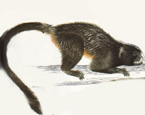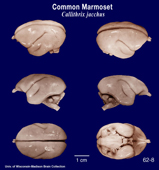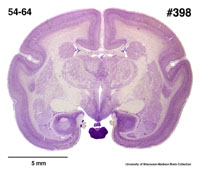|
Common Marmoset
(Callithrix jacchus) #54-64 |
||||
|
|
Physical
characteristics and distribution
|
|
Head and body length is 175-310 mm and tail length is 250-440
mm. Weights range from 225-900 g. Some, such as in the hairy-faced group, have long hairs
around the face and head. Some have mustaches while others have
short white hairs which cover the entire area around the mouth.
Coloration varies greatly among the species as do markings.
|
|
Description
of the brain
|
|
Animal
source and preparation
|
|
All
specimens collected followed the same preparation
and histological procedure.
|
Other Related Resources (websites and publications)
List of Specimens | Explore Collections | Brain Sections | Brain Evolution | Brain Development | Brain Circuitry | Brain Functions | Location and Use | Related Web Sites | Contact Us | Search MSU Database | Personnel | Home



